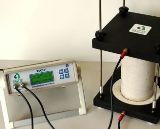Specific electrical resistance of water
 As a rule, water is supplied to the heating installations of the electrode from natural sources. The suitability of water for a certain technological process is determined by its physical and chemical parameters. In terms of electrode heating installations, the most important physical indicators of water quality are salinity and its salinity electrical resistance.
As a rule, water is supplied to the heating installations of the electrode from natural sources. The suitability of water for a certain technological process is determined by its physical and chemical parameters. In terms of electrode heating installations, the most important physical indicators of water quality are salinity and its salinity electrical resistance.
The salinity, i.e. the total concentration of all cations and anions contained in 1 kg of water varies from 50 mg/kg to several grams per kilogram.
The mode of operation of the electrode devices mainly depends on the specific electrical resistance of the water, which at any time determines the current and power of the device. For different seasons and geographical areas, the specific electrical resistance of water is different and ranges from 5 to 300 ohms. In special laboratories, this resistance is determined at a water temperature of 293 K using a conductometer (MM 34-04).
In practice, simpler, though less precise, settings are used.For direct measurement of the specific electrical resistance of water, it is possible to recommend a device consisting of an electrically insulating rectangular vessel, two flat copper electrodes fixed on the inner end walls of the vessel, two wire probes of 1 mm diameter placed in water at a known distance from the electrodes along a line perpendicular to their planes. The AC mains voltage is fed through an autotransformer to the electrodes. During the experiment, the temperature of the water in the vessel, the current in the electrical circuit and the voltage drop across the probes are determined.
Specific electrical resistance, Ohm-m, of water at a temperature of 293 K

where U3 is the voltage drop between the probes, V, Ae is the cross-sectional area of the water in the vessel perpendicular to the lines of force, m2, h3 is the distance between the probes, m, I is the current in the electrode circuit, A.
The specific electrical resistance, Ohm-m, at temperature T of weak solutions of electrolytes, including natural water, is described by a hyperbolic function of temperature

Here ρ293 is the electrical resistance at a temperature of 293 K, αt — temperature coefficient of electrical resistance, reflecting the relative decrease in electrical resistance with a 1 K increase in temperature.
For solutions of bases and salts αt = 0.02 … 0.035, acids αt = 0.01 … 0.016. In practical calculations, ρt is determined by a simplified expression such that αt = 0.025,

Electric water heatersas a rule, they work in closed heat supply systems without water removal, which makes it possible to stabilize the electric resistance, electric current and boiler power at the design level.Unlike boilers, the physical state of water during stationary operation of a steam boiler changes along the height of the electrode system.
In the lower zone of the system, water is heated to 358 ... 368 K, in the middle - to the boiling point at a given pressure in the boiler with the formation of steam bubbles, and in the upper zone, saturated steam is intensively formed.
The specific electrical resistance of such a complex structure of the working medium — a steam-water mixture — depends on the temperature and concentration of salts in the boiler water, the volume content of steam, the design parameters of the electrode system and other parameters. In the practice of calculating steam boilers, the electrical resistance of the steam-water mixture is determined from experimental data.
For electrode systems with coaxial cylindrical electrodes, electrical resistance, Ohm-m, steam-water mixture

where ρt is the specific electrical resistance of water at the boiling point, Ohm-m, β is a coefficient that takes into account the effect of evaporation on the specific electrical resistance of boiler water, P is the power of the electrode system of the steam boiler, W, dB is the diameter of the inner electrode, m, h is the height of the electrode system, m, rθ is the heat of vaporization, J / kg, ρp is the vapor density at a given pressure, kg / m3.
For a shielded electrode system with electrodes located at an angle of 120 ° and thermosiphon circulation of boiler water, the effect of evaporation on the electrical resistance of water can be taken into account by the correction factor β = 1.25 ... 1.3
